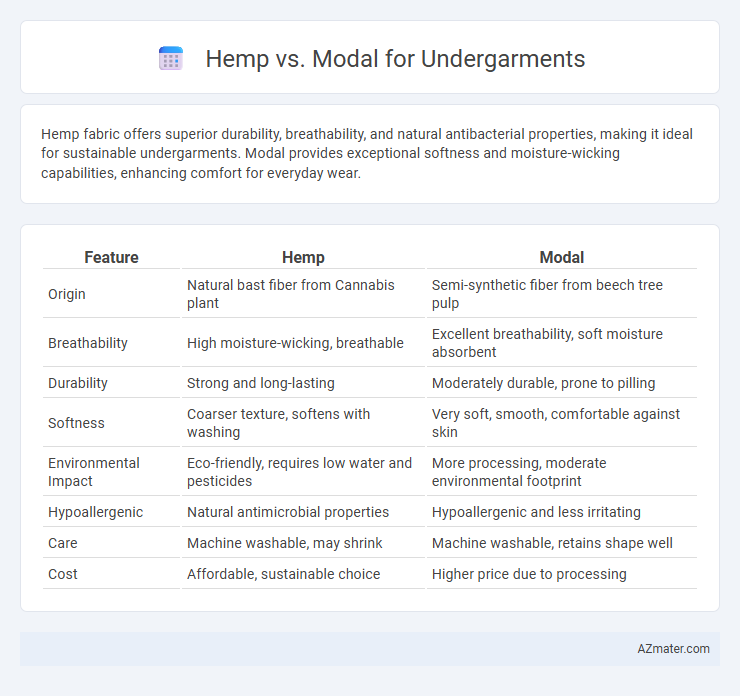Hemp fabric offers superior durability, breathability, and natural antibacterial properties, making it ideal for sustainable undergarments. Modal provides exceptional softness and moisture-wicking capabilities, enhancing comfort for everyday wear.
Table of Comparison
| Feature | Hemp | Modal |
|---|---|---|
| Origin | Natural bast fiber from Cannabis plant | Semi-synthetic fiber from beech tree pulp |
| Breathability | High moisture-wicking, breathable | Excellent breathability, soft moisture absorbent |
| Durability | Strong and long-lasting | Moderately durable, prone to pilling |
| Softness | Coarser texture, softens with washing | Very soft, smooth, comfortable against skin |
| Environmental Impact | Eco-friendly, requires low water and pesticides | More processing, moderate environmental footprint |
| Hypoallergenic | Natural antimicrobial properties | Hypoallergenic and less irritating |
| Care | Machine washable, may shrink | Machine washable, retains shape well |
| Cost | Affordable, sustainable choice | Higher price due to processing |
Introduction to Hemp and Modal Fabrics
Hemp fabric, derived from the durable fibers of the Cannabis sativa plant, is known for its strength, breathability, and natural antimicrobial properties, making it ideal for undergarments. Modal, a type of rayon made from beech tree pulp, offers a soft, smooth texture with excellent moisture-wicking abilities that enhances comfort in intimate apparel. Both fabrics provide eco-friendly alternatives to traditional materials, with hemp offering superior durability and modal excelling in softness and drape.
Sustainability: Hemp vs Modal
Hemp fabric excels in sustainability due to its rapid growth, minimal water requirements, and natural pest resistance, reducing the need for pesticides and fertilizers. Modal, derived from beech tree pulp, involves chemically intensive processes and higher water consumption, impacting its environmental footprint. Hemp's biodegradability and soil-enriching properties further strengthen its position as an eco-friendly choice for undergarments compared to modal.
Comfort and Softness Comparison
Hemp fabric offers durability and breathability but tends to feel coarser compared to modal, which is known for its exceptionally soft and smooth texture, making it ideal for undergarments that prioritize comfort. Modal's moisture-wicking properties enhance dryness and softness against the skin, providing a luxurious feel often preferred in intimate apparel. While hemp is more sustainable and antimicrobial, modal's superior softness often results in better overall comfort for daily wear undergarments.
Moisture Wicking and Breathability
Hemp fabric demonstrates superior moisture-wicking properties compared to modal, efficiently drawing sweat away from the skin to keep undergarments dry. Its natural breathability enhances air circulation, reducing heat buildup and odor, making it ideal for active wear. Modal offers softness but absorbs moisture more slowly, which may result in a less breathable and damp feel during extended wear.
Durability and Longevity
Hemp fibers exhibit superior durability and longevity compared to modal, with a natural resistance to wear and tear that extends the lifespan of undergarments. Hemp's robust tensile strength allows garments to maintain shape and integrity through multiple washes, making it ideal for long-term use. Modal, while soft and breathable, tends to degrade faster under continuous friction and washing, reducing its overall durability.
Skin Sensitivity and Hypoallergenic Properties
Hemp fabric exhibits superior hypoallergenic properties and is highly suitable for individuals with sensitive skin due to its natural antimicrobial qualities and breathability that reduce irritation and allergic reactions. Modal, derived from beech tree pulp, is also gentle on sensitive skin, offering a smooth, silky texture that minimizes friction and enhances comfort for delicate skin types. Both materials provide excellent moisture-wicking capabilities, but hemp's durability and natural resistance to mold and bacteria make it especially beneficial for undergarments aimed at maintaining skin health.
Environmental Impact of Production
Hemp fabric production consumes significantly less water and pesticides compared to modal, which is derived from chemically intensive processes using beech tree pulp. Hemp's rapid growth and ability to improve soil health make it a more sustainable choice, reducing deforestation and chemical runoff associated with modal manufacturing. Overall, hemp's lower environmental footprint positions it as a greener alternative for eco-conscious undergarment production.
Care and Maintenance Requirements
Hemp undergarments require minimal care, benefiting from natural antimicrobial properties that reduce odor and resist bacteria build-up, making them ideal for low-maintenance washing at moderate temperatures. Modal fabric, derived from beech tree pulp, demands gentle care with cold water washing and air drying to prevent shrinking and maintain softness, as it is more delicate and prone to pilling than hemp. Both materials benefit from avoiding high heat drying and harsh detergents to extend their longevity and preserve fabric integrity.
Cost Differences for Consumers
Hemp undergarments typically have higher upfront costs due to sustainable farming and processing methods, while modal fabrics, derived from beech tree pulp, often offer more affordable pricing because of mass production efficiencies. Despite the initial price disparity, hemp's durability and natural antimicrobial properties can result in longer-lasting wear, potentially reducing replacement frequency and overall cost for consumers. Modal provides a softer, smoother texture at a lower price point but may require more frequent replacement, impacting long-term affordability.
Choosing the Right Fabric for Undergarments
Hemp fabric offers exceptional breathability, moisture-wicking properties, and natural antibacterial benefits, making it ideal for undergarments worn in warm or active conditions. Modal, derived from beech trees, provides a soft, silky texture with excellent stretch and durability, enhancing comfort for everyday wear. Selecting between hemp and modal depends on prioritizing sustainability and odor control versus softness and elasticity in undergarment fabrics.

Infographic: Hemp vs Modal for Undergarment
 azmater.com
azmater.com